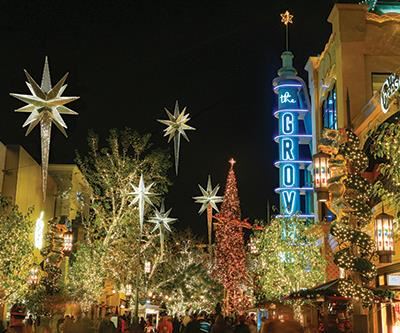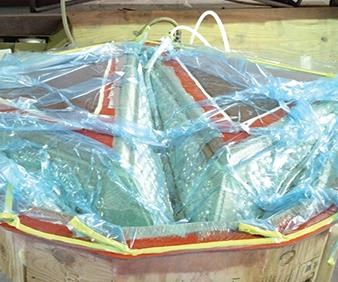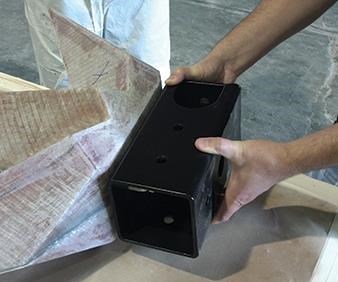Composite stars brighten the holidays
Light, durable design pleases eyes and budget.
T’was the season for such delights.
Designer Stephen Stefanou and his team of artisans and engineers at Venue Arts (Dallas, TX, US) are known for stunning displays at the MGM Macau Resort and Casino (Macau, China) and US destinations, such as New York City’s Rockefeller Center and Bellaggio Las Vegas (Las Vegas, NV). The company also creates unique structures for commercial buildings, product launches and political events. But one of its key markets is holiday installations, at shopping and entertainment centers around the world. Fiber-reinforced plastics (FRPs) are becoming a common construction material for this industry, and they featured prominently in Venue Arts’ creation of the 14-point Moravian stars for Los Angeles, CA, US-based retail complex, The Grove, in anticipation of its 2014 Christmas season.
The Grove project’s design called for an array of Moravian stars covered with mirrored tiles. “The engineering criteria for this project really drove us toward the material,” says Stefanou. “Composites are very stable with respect to thermal expansion,” Stefanou points out, noting that this property was important to project success because, “the location was subject to large swings in temperature from day to night.” Moisture resistance also was key, because winter is Southern California’s rainy season. “These parts are assembled and disassembled every year,” explains Stefanou. “Composites’ stability offers increased longevity, so that the parts continue to fit together and maintain their aesthetics.” He notes that the composites industry itself also played a part in Venue Art’s selection process, because long-time suppliers and new manufacturers are looking for new markets and offering more affordable formats.
Stefanou appreciated the greater flexibility that composites’ high strength, stiffness and low weight offered Venue Arts in its approach to display design and construction. “For example, I am no longer restricted to only hanging the star from its top, but can choose, alternatively, to hang [it] from its side arms,” says Stefanou. “This aids us in designing and implementing installations that meet both aesthetic and cost requirements.”
He points out that the tooling processes proposed by fabrication partner Vectorworks Marine(Titusville, FL, US) also made the project more affordable. “The composition of the display design called for stars of three different heights: 2.7m, 3.7m and 4.2m,” explains Stefanou. Vectorworks used Venue Arts’ 3D computer designs to CNC machine three sizes of plugs, which it used to produce glass fiber composite molds. Vectorworks then used the molds to fabricate the composite parts for each star, which included two three-point pieces, two large points and six small points. Dry E-glass fabrics from Vectorply Corp. (Phenix City, AL, US) and polyvinyl chloride (PVC) foam core from DIAB Americas LP (DeSoto, TX, US) were wet laminated with an Interplastic Corp. (St. Paul, MN, US) vinyl ester resin, then vacuum bagged and consolidated. Although cure was about 30 minutes at room temperature, the parts were typically left overnight before demolding. Each star part was formed from two molded halves, which were bonded together using ACRALOCK methyl methacrylate adhesive from Engineered Bonding Solutions LLC (Titusville, FL, US). Completed star parts were then mechanically fastened to a central steel box (see photo at left) to enable easy disassembly and storage during the off-season.
“Composite materials allow me to work at a larger scale,” Stefanou sums up, “and their light weight and high strength have expanded our design possibilities.”
See a video of The Grove project here.
See links to some of Venue Arts’ other fantastic displays here.
Related Content
Sulapac introduces Sulapac Flow 1.7 to replace PLA, ABS and PP in FDM, FGF
Available as filament and granules for extrusion, new wood composite matches properties yet is compostable, eliminates microplastics and reduces carbon footprint.
Read MoreThe lessons behind OceanGate
Carbon fiber composites faced much criticism in the wake of the OceanGate submersible accident. CW’s publisher Jeff Sloan explains that it’s not that simple.
Read MorePEEK vs. PEKK vs. PAEK and continuous compression molding
Suppliers of thermoplastics and carbon fiber chime in regarding PEEK vs. PEKK, and now PAEK, as well as in-situ consolidation — the supply chain for thermoplastic tape composites continues to evolve.
Read MoreBio-based acrylonitrile for carbon fiber manufacture
The quest for a sustainable source of acrylonitrile for carbon fiber manufacture has made the leap from the lab to the market.
Read MoreRead Next
Plant tour: Daher Shap’in TechCenter and composites production plant, Saint-Aignan-de-Grandlieu, France
Co-located R&D and production advance OOA thermosets, thermoplastics, welding, recycling and digital technologies for faster processing and certification of lighter, more sustainable composites.
Read MoreVIDEO: High-volume processing for fiberglass components
Cannon Ergos, a company specializing in high-ton presses and equipment for composites fabrication and plastics processing, displayed automotive and industrial components at CAMX 2024.
Read MoreDeveloping bonded composite repair for ships, offshore units
Bureau Veritas and industry partners issue guidelines and pave the way for certification via StrengthBond Offshore project.
Read More


























